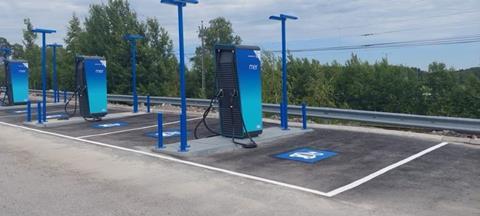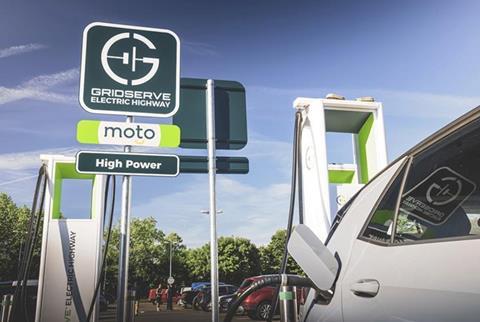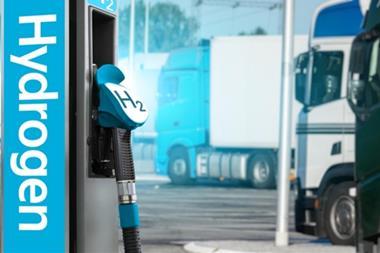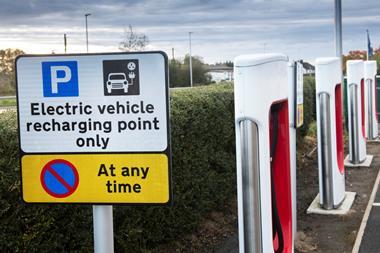To invest or not to invest in EV charging? That’s the big question for a lot of you at the moment. But what if a third party does the investing for you?
That’s what happened for Top 50 Indie Sharma Garages Group, which has BP Pulse chargepoints live at its BP Ward End site and more coming online at its BP Swift site in April.
Managing director Kumar Sharma, takes up the story: “With EV charging, I knew getting started could take time, but I also knew I would rather get in first and gather those extra customers, but it all depends on the deal and the BP Pulse deal was right for me. We looked at the sums involved and saw that, as a dealer, if we had invested, we wouldn’t get our money back for a long time. So, we thought, let the big boys take on the challenge. We did enquire with other suppliers as well, but their leases were much longer, typically 20 years. With the BP Pulse deal, it’s only a 10-year lease so it’s shorter and risk free. But one thing I did say to BP was that if you want to attract customers, we need to have the fastest chargers, so we’ve got 300 kW.”
The chargers went live at Ward End, Birmingham a year ago and Kumar reports that everything went pretty smoothly. He says they have the fastest chargers in the area and BP is very happy with the way things are going.
How can forecourts prepare for growing EV demand?
Forecourt owners face increasing challenges to implement the growing trend of electric vehicles (EVs), so what’s the solution?
Last year, the number of fully electric vehicles on UK roads exceeded 975,000 and plug-in hybrids 590,000. An additional 315,000 battery electric cars were registered last year and EV numbers ramped up by 18% in 2022, data in a report commissioned by European EV charging company Mer shows.
As a result, the opportunities for forecourt owners to cash in on the growth are many, but how do they go about this?
Find out how to avoid complexities when installing EV charging points and what the breadth of opportunities are.
Drivers using the chargers do use Kumar’s shop too, but he expects more of that at BP Swift when the chargers there go live in April.
BP Swift is situated at junction 15 of the M6 at Newcastle under Lyme and re-opened last year after a knockdown rebuild. “As this is a motorway site, we are expecting more use of the shop to buy coffee etc,” he says.
Kumar is making an investment in charging at BP Swift in the form of a canopy. “Swift is quite exposed, and our weather is often windy and wet so we decided to invest in a canopy so people can shelter from the wind and rain. This means we have a pleasant and safe environment in which to charge – with shelter, lights and facilities close by.”
Kumar is always keeping an eye on what’s happening in the EV market and given that new vehicle sales are predominantly fleet sales and purchases by private individuals are down, he is sticking to just two sites with charging at the moment.
Yogan Yoganathan at Top 50 Indie JP&S Services is of a similar view to Kumar in letting the big boys do the investing. He has plans to redevelop his Ockford Service Station in a project that will start soon.
“Jet are doing the investing for us – in two charging bays at the site. We weighed up our spending versus the income and the Jet deal was the best way forward for us. We will be leasing two bays to them.”

Fully funded solution
Meanwhile, EV charging company Mer offers forecourt operators and other landowners a range of flexible financing options, including fully funding the entire process from planning to maintenance. This is the option that Top 50 Indie, AY&Y Patel went for. Mer was responsible for the installation and is now in charge of the full operation and maintenance of the EV chargepoints. This means AY&Y can offer renewable energy EV charging to its customers, free from financial risk and also potential physical risks from technical obsolescence or vandalism.
Elizabeth Warren, interim director of public charging at Mer UK, says: “National and local grid capacity are possibly the most inhibiting factors for the EV charging infrastructure. There’s no shortage of energy to power vehicles as more energy from renewable sources comes on stream. But there is a shortage of capacity to get renewable energy to where it is needed, and that includes forecourts.
“A great deal of the work done by our charging teams involves helping forecourt operators, like AY&Y Patel gear up their electricity supply to handle the volume of energy EVs require. This often means upgrading their connections from the grid via their DNOs (distribution network operators). EV forecourt charging developments can take as long as 18 months to install as they involve specialist surveys to avoid hazards on forecourts. Without doubt, these projects take time and effort to get the necessary permissions and do the groundwork, including obtaining wayleaves. Partnering with specialist, experienced EV charge point operators like Mer makes the world of difference.”
The 15-year agreement with AY&Y Patel has seen Mer deliver a fully funded, turnkey forecourt EV charging solution comprising three Alpitronic 400kW chargepoints for six EV charging bays. The three Alpitronic hyperchargers each have a charging power of up to 400kW, which Mer says is more than sufficient for today’s EVs and will ensure that AY&Y Patel’s EV chargepoint installation is fit for the future. They feature dynamic charging and contactless payment as required by the Government’s regulation for payment interoperability at public charge points.

Accelerated progress
Sticking with Top 50 Indies, Moto has 571 ultra-rapid charging bays at 37 of its sites, and this number will continue to grow this year.
When asked why the other 11 Moto sites don’t have chargers, Ken McMeikan, chief executive at Moto, says: “While we are delivering an industry-leading rollout of ultra-rapid charging bays across the UK, we have to continually overcome the significant barriers that have caused delays at some of our sites, such as a lack of access to power and outdated planning laws.
“Recent announcements from the government aimed at transforming the planning system in favour of delivering low-carbon energy projects and prioritising EV charging hubs have been very encouraging. However, to make accelerated progress to meet EV charging demand well into the future, it’s vital that the government now prioritises delivery of power to motorway service areas to allow us to make even more charging bays available to EV drivers on the UK’s strategic road network.”
Ken says they are committed to transforming the experience for EV drivers and, along with partners Gridserve and Tesla, will continue to lead an ambitious rollout of ultra-rapid charging bays to provide “reliability, simplicity and speed of charging” at all of Moto’s sites.
He explains that some Moto sites are busier than others, simply due to differing volumes of traffic in regions that have higher concentrations of EV drivers.
“Peak times during the year that lead to a mass movement of drivers on the UK’s motorways, such as Christmas and school holidays, also impact the levels of EV charging too. At Moto, our EV charging hubs are strategically placed across the whole of the UK’s strategic road network to meet demand during these periods.”
Moto was in the national press for using marshalls at really busy charging times. Says Ken: “In response to busy periods, we’ve worked closely with our partners at Tesla and Gridserve to ensure colleagues are on hand at a number of our busiest sites to manage the flow of EV traffic and identify available chargers and bays, as well as providing reassurance and a visual presence to coordinate EV drivers during busy times.”
“This is about giving our customers the best experience by trying to stop queues building up in the first place – something we have been really successful with even at peak holiday travel times on our busiest sites.”
It’s the chargepoint operators who set the prices at Moto’s EV charging facilities, but Ken says Moto is focused on ensuring its customers are offered competitive pricing. “An example of this is Gridserve’s pricing is consistent across the rest of their network away from motorways and doesn’t vary site to site.
“To support a reduction in the cost of public charging, Moto have called on the UK government to scrap the 20% rate of VAT on public chargers or to bring it in line with the home-charging rate at 5% in our “motofesto”, which will drive down the cost of using public chargers for EV drivers.”
He says customer response to the EV charging hubs has been incredible: “This was something we’d seen in the most recent results from Transport Focus’ Motorway Service Users Survey results. Some 92% of our customers stated they were satisfied with both the ease of using a charging point and waiting times at our sites, which are two of our key customer service metrics for EV drivers – these were above the average results across all motorway services operators and is something we’re really proud of at Moto.”
When asked what he might say to other forecourt operators who are hesitant about investing in chargers, Ken says: “Ultimately, the aim of having a reliable and efficient EV charging network across the UK will increase the levels of EV adoption among consumers and is to key to decarbonising the UK’s road transport sector on our collective journey to Net Zero as a nation.
“Therefore, it’s vital that industry continues to expand its EV charging facilities at a rapid pace. At Moto we’re enormously proud to be industry-leading in this respect.”


























